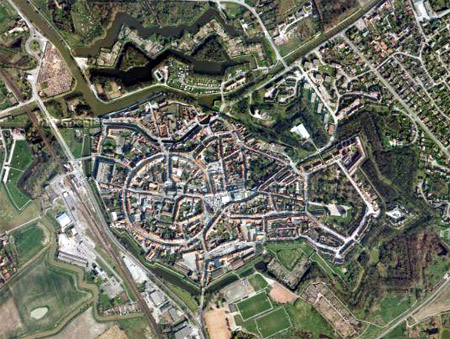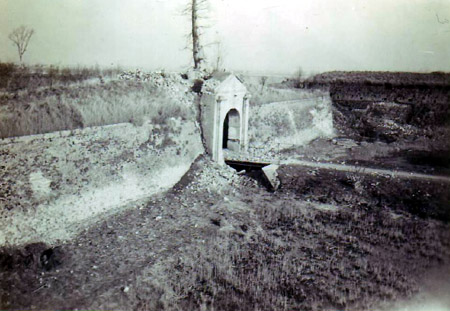 |
Fort Vallières
Coudekerque-Branche, France
|
|
 |
Five miles south of the French city of Dunkirk and fifteen miles west of the Belgian border lies Bergues. Dunkirk wasn't developed into an actual city until the late 17th century, so Bergues, connected to the English Channel by a river, served as an important port city for 800 years.
The first ramshackle, wooden fortification built to protect Bergues was erected in 882AD by Count Baldwin II (865-918), when the Normans began their incursions into the region. Bergues grew independently of France as a member of the Hanseatic League, a commercial and defensive confederation of merchant guilds and market towns that dominated trade along the northern coast of Europe from the 13th through 17th centuries.
What is now Belgium and some of northern France was, in the 16th through 18th centuries, part of the
|
 |
|
|
Spanish Netherlands. The colonial Spanish dudes 'n' dames who were in charge of this weirdness didn't take kindly to such independent towns as Bergues, particularly when there were independent-minded revoltings afoot. One of these dudes was Alexander Farnese (1545-1592), the Governor-General of the Spanish Netherlands, who was sent to put down the uprisings that were impolitely springing up in these proud Spanish lands.
Uprisings successfully subdued, the Spanish built a redoubt near Bergues to forestall any future foolishness. Although Spanish forces were mostly successful over the French in the War of Devolution (1667-1668), the allied English, Dutch and Swedish forced them to give up most of what they had conquered back to France, in the Treaty of Aix-la-Chapelle (1668). Bergues was French again!
|
 Bergues is a nice little starfort of a town in & of itself! Bergues is a nice little starfort of a town in & of itself! |
 |
Vauban himself determined that the defense of Bergues was worthy of his masterful works, and designed and built both what is today Fort Vallières and the nearby Fort Louis from 1672 to 1676. The most important aspect of Fort Vallières at the time seems to have been its chapel, which was a popular destination for those in the vicinity. The Dominican chaplains who operated the chapel were somehow put in charge of naming the fort itself, which they indifferently referred to as Fort St. Francis, Fort François, and/or Fort French.
Whatever it was called, it must have been a sumptuous fort indeed,
|
|
because through the 18th century Fort St. Francis/François/French was the focus of much high-society beverage sipping. King Louis XIV (1638-1715) had made the development of Dunkirk into a viable port city a priority at the beginning of the 18th century, however, so Bergues' days as an important commercial hub were numbered.
In the early days of the French Revolutionary War (1792-1802), France declared war on just about everybody they could think of. As a result, England's Prince Frederick, Duke of York (1763-1827) was at the head of a British/Hanoverian army that was marching around northern France besieging things in 1793. Fort Vallières (which technically wasn't known as Fort Vallières yet, but in the interest of retaining some small amount of sanity I'll just start referring to it as such at this point) played an important role in York's failed siege of Dunkirk, in that the Bergues Canal was blocked at the fort, helping to flood the land around Dunkirk. This made things unpleasant for York's troops (You want us to fight in wet boots? Forget it!), which helped lead to the British defeat at the Battle of Hondschoote (September 6-8, 1793).
 Fort Louis and Fort Vallières on the Bergues Canal. Why were two Vauban forts deemed necessary in such close proximity? If you run into Vauban, be sure to ask him. Fort Louis and Fort Vallières on the Bergues Canal. Why were two Vauban forts deemed necessary in such close proximity? If you run into Vauban, be sure to ask him.
Toward the end of the 19th century, the fort of our current interest finally achieved the name Vallières. Which person named Vallières it was named after is in dispute: Either a friend of King Louis XIV or a Governor of Bergues. Whatever, it's a much better name than Fort St. Francis/François/French.
During the Franco-Prussian War (1870-1871), Prussian prisoners of war were housed at Fort Vallières. During the First World War (1914-1918), an army radio station was operational at the fort, and anti-aircraft guns were installed in 1917. Locals came during air raids to hunker down and wait out the bombing.
|
In 1940, Fort Vallières was serving as a French Navy radio outpost, and received two 155mm artillery pieces on May 26th, to help defend Bergues from the coming German tide. The Nazis felt that this 17th century fort was worthy of some attention in their Dunkirk-conquering process, so sent Stukas to do some of the dive-bombing for which they are justly famous, on June the 1st.
Fort Vallières' drawbridge was damaged, making resupply of ammunition impossible. The fort's garrison managed to evacuate the big guns while under fire, and then |
 |
 Fort Vallières' gate in 1946 Fort Vallières' gate in 1946 |
|
headed to help in the defense of Dunkirk...which fell to the Germans on June 4, 1940. 80% of Bergues was destroyed during the Second World War (1939-1945): Had the attacking Germans done so on foot, using only 16th or 17th century weapons, Fort Vallières would've sent them back to Berlin with bloody noses: Had technology stopped dead in the 17th century, starforts would still rule the waves today. BUT this whole mechanized warfare thing somehow came into being, and starforts were left behind. Sorry, Bergues!
The French government shoved the ruined fort towards local residents in 1961 and said something like, "Here, y'want this piece of junk?" The city of Dunkirk acquired Fort Vallières in 1967 and set about making it a useful property. Today, it's difficult to surmise how useful it might be, but the fort is obviously a regional tourist attraction.
|
|
|
|
|
|
 |




